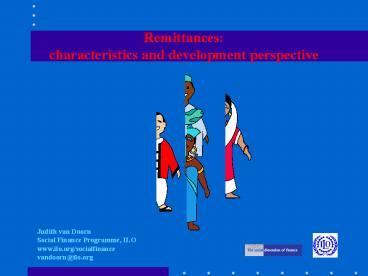Remittances: characteristics and development perspective PowerPoint PPT Presentation
1 / 16
Title: Remittances: characteristics and development perspective
1
Remittances characteristics and development
perspective
Judith van DoornSocial Finance Programme, ILO
www.ilo.org/socialfinancevandoorn_at_ilo.org
2
Whats next
- Remittances and the ILO
- ILO field studies - characteristics-
development issues - Suggested future work areas
3
Remittances and the ILO
- ILO Labour Standards
- migrant workers have the right to transfer
(part of) their earnings and savings through
their preferred channel - Migration Labour Conference 2004
- Access to finance
- - market-conform, and incentives-based-
partnerships
4
Remittances and the ILO
- Activities
- Platforms
- Field studies - Bdesh, Nepal, Senegal
- Pilot projects .. (next step)
5
Characteristics
- Volume of remittancesBangladesh 1.8
billionNepal gt 1 billion Senegal
300 million Informal transfers are huge..
6
Characteristics
- Why are informal transfers so popular?
- Better exchange rate (hundi Nepal)
- Non-financial services
- No access to banking services
- No experience with banking (Nepal example)
7
Characteristics
- Remittances as of recipients income
- Bangladesh gt 50
- Senegal up to 90...
8
Characteristics
Use of remittances
- Top 5
- Consumption
- Land
- Housing
- School fees
- Collective investments (food depots, mosques,
schools, health centres)(Nepal India savings
and credit associations)
9
Development
- Savings
- Availability of suitable savings products?
- Trust in formal savings mechanisms?
- Demands from the (extended) family?
- Some migrants are saving abroad
10
Development
- Access to banking services
- Bangladesh- Islami Bank
- Pro-active approach to attract remittances.
- Staff visited migrants at work place and at
home. - Developed fine-tuned products (e.g. accounts
for migrants associations)
11
Development
- Policies and regulation
- NepalCentral Bank encourages establishment of
private operators. Formalising hundi - SenegalBanking law only allows banks and
regulated institutions to engage in intl money
transfers. Inhibits the establishment of private
operators.
12
Development
- Policies and regulation
- Bangladesh
- Government encourages Bdeshi banks to open
correspondent relationships with financial
institutions abroad. - Remittances are tax free
13
Development
- Remittances are mainly used for consumption.
- What is their development impact?
- Study, Bangladesh multiplier effect 3.3 on GNP
2.8 on consumption - 0.4 on investment
- Remittances often larger than ODA
- Remittances to Senegal increased over the last 5
years7 -gt 82 of ODA. ODA decreased during
that same period.
14
Development
- Do remittances create inequalities in the
community? - No clear answer. Example Nepal
15
Suggested work areas
- Development actorsLink financial institutions
(e.g. banks MFIs)Assist financial insitutions
to develop follow-up products - EmployersTransfer remittances
- Trade unions / civil societyInform migrants of
remittance issues - GovernmentsFacilitate / stimulate
16
Remittances characteristics and development
perspective
Judith van DoornSocial Finance Programme, ILO
www.ilo.org/socialfinancevandoorn_at_ilo.org

